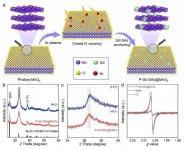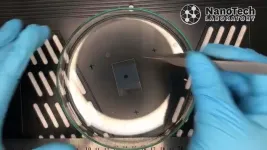(Press-News.org) An international group of researchers has developed a novel approach that enhances the efficiency of the oxygen evolution reaction (OER), a key process in renewable energy technologies. By introducing rare earth single atoms into manganese oxide (MnO2), the group successfully modulated oxygen electronic states, leading to unprecedented improvements in OER performance.
Their findings were published in the journal Nano Energy on June 10, 2024.
Transition-metal-based oxides have been widely explored for their potential as active OER catalysts. However, the capacity of these catalysts is hindered by the adsorbate evolution mechanism, which limits the effective release of oxygen (O2) during the reaction.
"We constructed localized asymmetric gadolinium-oxygen-manganese units on MnO2, which helps accumulate electrons at oxygen sites," notes Hao Li, corresponding author of the paper and an associate professor at the Advanced Institute for Materials Research (WPI-AIMR) at Tohoku University. "By doing this, the catalysts achieve a lower overpotential and maintain stability over time, making it a suitable alternative to traditional catalysts such as ruthenium dioxide (RuO2)."
Hao Li and his colleagues employed an argon plasma-assisted strategy to introduce rare earth elements on the catalyst surface. In this strategy, argon gas is ionized, energizing and helping break the argon atoms into ions and electrons, thereby making it easier to interact with and modify materials.
"We have addressed the challenges associated with the adsorbate evolution mechanism that limits the performance of transition-metal-based oxides like MnO2," adds Di Zhang, co-author of the study and a Specially Appointed Assistant Professor at WPI-AIMR. "By improving the understanding of the structure-activity relationship under the lattice oxygen mechanism, the research provides a foundation for more effective catalyst design."
Building on the success of this study, the group plans to extend their methodology to a variety of electrochemical reactions. This approach will help further decipher unique structure-activity correlations, ultimately contributing to the design of even more effective and high-performance electrocatalysts.
END
Rare earth single atoms enhance manganese oxide's electrochemical oxygen evolution
2024-08-29
ELSE PRESS RELEASES FROM THIS DATE:
Gria: An efficient deterministic concurrency control protocol
2024-08-29
The concurrency control in deterministic databases, i.e., deterministic concurrency control, ensures that each transaction batch produces a unique result. In this way, replicas can process transactions in batches without communicating with each other to ensure consistency, which is simpler and more efficient than non-deterministic databases in achieving high availability through replication.
Early deterministic concurrency control protocols, e.g. Calvin, Bohm, PWV, rely on the prior knowledge of the read-write set, which is impractical in most scenarios. The state-of-the-art Ari breaks this limitation. However, Aria has three issues. First, ...
NSF grants $22 million for 'extreme microbe' lab collaboration
2024-08-29
The National Science Foundation has announced a $22 million grant to establish a “BioFoundry” laboratory for the study of extreme microorganisms with collaborating facilities at UC Riverside, UC Santa Barbara, and Cal Poly Pomona.
The BioFoundry for Extreme and Exceptional Fungi, Archaea, and Bacteria, or ExFAB, will focus on developing techniques to learn from nature’s more unusual microorganisms. These microbes are considered “extreme” because they have unusual nutritional requirements, grow at extremely high or low temperatures, or grow without ...
UC Santa Barbara to lead $22M NSF-funded center on exceptional microbes
2024-08-29
(Santa Barbara, Calif.) — This week, the National Science Foundation announced the award of a six-year, $22M grant to UC Santa Barbara under its biofoundries program for the establishment of the BioFoundry for Extreme and Exceptional Fungi, Archaea and Bacteria (ExFAB), a collaboration led by UC Santa Barbara (UCSB), together with UC Riverside (UCR), and Cal Poly Pomona (CPP). ExFAB establishes the nation’s first biofoundry that focuses on largely untapped and unexplored extreme microbes. UCSB's award is one of only five grants made under NSF's BioFoundry program during this funding cycle, which awarded ...
Misconceptions about dyslexia among professionals risk children being misdiagnosed
2024-08-29
Misconceptions about dyslexia are held by professionals who assess children for the learning difficulty, according to a new study which calls for evidence-based standardised assessment procedures.
The research, led by Durham University, found that almost half of dyslexia professionals in the study believed at least one unproven indicator for dyslexia, which could lead to children being misdiagnosed.
In a survey of 275 dyslexia professionals, the most common myth – which is not backed up by solid evidence – was that people with dyslexia read letters in reverse order, believed by 61 per cent of specialists.
Just over 30 per cent of professionals also ...
Breakthrough in semiconductor patterning: New block copolymer achieves 7.6 nm line width
2024-08-29
A recently developed block copolymer could help push the limits of integration and miniaturization in semiconductor manufacturing, report scientists in Tokyo Tech and TOK. Chemically tailored for reliable directed self-assembly, the proposed compound can arrange itself into perpendicular lamellar structures whose half-pitch width is less than 10 nanometers, outperforming conventional and widely used block copolymers.
Miniaturization is one of the fundamental qualities of modern electronics and is largely responsible for the incredible increments in performance witnessed ...
Fission chips – How vinegar could revolutionize sensor processing
2024-08-29
Researchers at Macquarie University have developed a new way to produce ultraviolet (UV) light sensors, which could lead to more efficient and flexible wearable devices.
The study, published in the journal Small in July, shows how acetic acid vapour – essentially vinegar fumes – can rapidly improve the performance of zinc oxide nanoparticle-based sensors without using high-temperatures for processing.
Co-author Professor Shujuan Huang, from the School of Engineering at Macquarie University, says: “We found by briefly exposing the sensor to vinegar vapour, adjoining ...
Certain diabetes drugs might prevent dementia
2024-08-29
Sodium-glucose cotransporter-2 (SGLT-2) inhibitors used to treat type 2 diabetes might prevent dementia, providing greater benefits with longer treatment, suggests a large study from Korea published by The BMJ today.
As this study was observational, the researchers note that the effect size could have been overestimated and say randomised controlled trials are now needed to confirm these findings.
According to the World Health Organization, the number of people with dementia globally is expected to reach 78 million ...
Lower HPV vaccination coverage among girls with mental health conditions
2024-08-29
Girls with mental illness or neurodevelopmental conditions are less likely than their peers to be vaccinated with the HPV vaccine that protects against future cervical cancer. This is according to a new registry study from Karolinska Institutet in Sweden published in The Lancet Public Health.
The study involved more than 115,000 girls covered by the Swedish school-based human papillomavirus (HPV) vaccination programme. The vaccine, which prevents cervical cancer, among other things, is offered to all children in Sweden and given by school health services.
Significant ...
Scientists discover how the body's killer cells attack cancer
2024-08-29
Scientists are on the verge of a cancer breakthrough after working out how the body’s immune system targets cells devastated by the disease.
A new study has discovered that our natural killer cells, from the immune system which protect against disease and infections, instinctively recognise and attack a protein that drives cancer growth.
The experts say that by hijacking this protein, known as XPO1, they may be able to activate more killer cells to destroy the disease.
Scientists from the University of Southampton, working with experts worldwide, led the study and now believe it could offer new ...
Interprofessional training in health sciences education has a lasting impact on practice
2024-08-29
Geriatrics experts have long known that collaboration is key to delivering quality, patient-centered care to older adults.
That’s why USC’s Interprofessional Education and Collaboration for Geriatrics (IECG) trains up to 150 students annually from seven health professions to teach the importance of teamwork in meeting the complex needs of the elderly.
Now, a study published in the Journal of Interprofessional Care highlights the long-term impact of IECG on USC health sciences graduates.
Researchers surveyed graduates one to three years after completing IECG to assess how the program influenced their practice. The findings were significant: 81% ...







